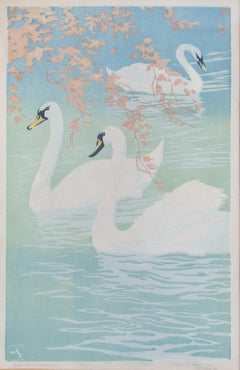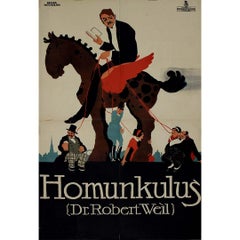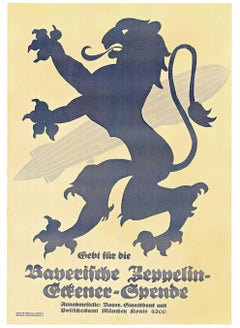Hans Neumann Art
to
1
1
Overall Width
to
Overall Height
to
2
2
2
1
1
1
1
1
1
1
1
1
1
1
2
10,083
2,779
1,379
1,375
1
1
1
Artist: Hans Neumann
Swans Woodblock by Hans Neumann, 1913
By Hans Neumann
Located in New York, NY
Hans Neumann (German, 1873 - 1957)
Schwäne (Swans), 1913
Woodblock
Sight: 17 x 11 in.
Framed: 25 3/4 x 19 in.
Signed & inscribed bottom, artist monogram lower left
This outstanding ...
Category
1910s Academic Hans Neumann Art
Materials
Woodcut
1919 original movie poster for Homunkulus, created by Hans Neumann
By Hans Neumann
Located in PARIS, FR
The 1919 original poster for Homunkulus, created by Hans Neumann, is a striking example of early 20th-century film advertising, capturing the spirit of the silent film era with bold ...
Category
1910s Hans Neumann Art
Materials
Paper, Lithograph
Related Items
René Magritte - LA VALSE HESITATION. Limited Surrealism French Contemporary
By (after) René Magritte
Located in Madrid, Madrid
René Magritte - LA VALSE HESITATION, 1950 (THE HESITATION WALTZ)
Date of creation: 2010
Medium: Lithograph on BFK Rives Paper
Edition number: 131/275
Size: 60 x 45 cm
Condition: New,...
Category
Mid-20th Century Surrealist Hans Neumann Art
Materials
Paper, Lithograph
$957 Sale Price
20% Off
H 17.72 in W 23.63 in
Original 1925 Zeppelin "Bayerische Zeppelin Eckene-Spende" vintage air travel
Located in Spokane, WA
Original German poster: Bayerische Zeppelin-Eckener Spende. 1925. (Bavarian Zeppelin-Eckener donation). Printer: M. Grunst, München. Condition: Grade A. Archival linen-back...
Category
1920s Academic Hans Neumann Art
Materials
Lithograph
$1,998
H 34.5 in W 24.25 in D 0.3 in
“The Winter Ball” 1988
Located in Austin, TX
Poster Size: 23.5 x 16.5 in.
Vintage Gold Leaf Frame Size: 23.5 x 16.5 in.
Signed and inscribed in gold marker, bottom right
A poster for "The Winter Ball 1988" in Houston, Texas, p...
Category
1980s Pop Art Hans Neumann Art
Materials
Paper, Lithograph, Offset
"Winter Wildfowling" Frank Weston Benson, Hunting Scene, Outdoors, Marshes
By Frank Weston Benson
Located in New York, NY
Frank Weston Benson
Winter Wildfowling, 1927
Signed lower left
Etching on paper
Image 8 1/2 x 7 inches
Born in Salem, Massachusetts, a descendant of a long line of sea captains, Benson first studied art at Boston’s Museum School where he became editor of the student magazine. In 1883, Benson enrolled at the Académie Julian in Paris where artists such as Bouguereau, Lefebvre, Constant, Doucet and Boulanger taught students from all over Europe and America. It was Boulanger who gave Benson his highest commendation. “Young man,” he said, “Your career is in your hands . . . you will do very well.” Benson’s parents gave him a present of one thousand dollars a twenty-first birthday and told him to return home when it ran out. The money lasted long enough to provide Benson with two years of schooling in Paris, a summer at the seaside village of Concarneau in Brittany and travel in England.
Upon returning to America, Benson opened a studio on Salem’s Chestnut Street and began painting portraits of family and friends. An oil of his wife, Ellen Perry Peirson, dressed in her wedding gown is representative of this period. It demonstrates not only the academic techniques he learned at the Academie Julian but also his own growing emphasis on the effects of light. And yet, despite all the technical mastery displayed in the work, the painting exudes the warmth that existed between model and artist. More than a likeness, it is a study in serenity. Perhaps it was of a work such as this that Benson was thinking when he said, “The more a painter knows about his subject, the more he studies and understands it, the more the true nature of it is perceived by whoever looks at it, even though it is extremely subtle and not easy to see or understand. A painter must search deeply into the aspects of a subject, must know and understand it thoroughly before he can represent it well.”
Following a brief stint as an instructor at the Portland, Maine, Society of Art, Benson was appointed as instructor of antique drawing at the Museum School in Boston in the spring of l889. Benson’s long association with the school was particularly fruitful. Under the leadership of Edmund Tarbell and Benson the Museum School became a national and internationally recognized institution. The students won numerous prizes, enrollment tripled, a new school building was erected and visiting delegations from other schools sought the secret of their success. Benson cherished his role as teacher and was held in high esteem by his students, many of whom called him “Cher Maitre.” Reminiscing about his long career with the school Benson once said, “I may have taught many students, but it was I who learned the most.”
In 1890, Benson won the Hallgarten Prize at the National Academy in New York. It was the first of a long series of awards, that earning for him the sobriquet “America’s Most Medalled Painter.” In the early years of his career, Benson’s studio works were mostly portraits or paintings of figures set in richly appointed interiors. Young women in white stretch their hands out towards the glow of an unseen fire; girls converse on an antique settee in a room full of objets d’arts; his first daughter, Eleanor, poses with her cat. Works of this sort, together with a steady influx of portrait commissions, earned Benson both renown and financial rewards, yet it was in his outdoor works that gave Benson his greatest pleasure.
In the latter half of the 1890s, Benson summered in Newcastle, on New Hampshire’s short stretch of seacoast. It was here, in 1899, that Benson made his first foray into impressionism with Children in the Woods and The Sisters, the latter a sun-dappled study of his two youngest daughters, Sylvia and Elisabeth.
This painting was one of the first works that Benson hung at an exhibition with nine friends. The resignation of these ten illustrious artists rocked the American art establishment but, the catalogue for their first exhibition was titled, simply, “Ten American Painters.” When, in 1898, the three Bostonians and seven New Yorkers began to exhibit their best work in exquisitely arranged small shows, the group (dubbed by newspapers, “The Ten” ) quickly became known as the American Impressionists, a bow to the style of their French predecessors. The Ten’s annual shows soon became an eagerly awaited part of the annual exhibition calendar and were always well reviewed. Held annually in New York City, the group’s yearly exhibitions usually traveled to Boston and were occasionally seen in other cities. Benson’s association with other members of the group such as Childe Hassam, Thomas Dewing, William Merrit Chase and J. Alden Weir, only reinforced his growing emphasis on the tenets of Impressionism. As he later said to his daughter Eleanor, “I follow the light, where it comes from, where it goes.”
The principles of Impressionism began to dominate Benson’s work by 1901, the year that the Bensons first summered on the island of North Haven in Maine’s Penobscot Bay. His summer home “Wooster Farm,” which they rented and finally bought in 1906, became the setting for some of Benson’s best known work and there, it seemed, he found endless inspiration. Benson’s sparkling plein-air paintings of his children–Eleanor, George, Elisabeth and Sylvia–capture the very essence of summer and have been widely reproduced: In The Hilltop, George and Eleanor watch the sailboat races from the headland near their house.
As a boy, Benson dreamed of being an ornithological illustrator. In mid-life, he returned to the wildfowl and sporting subjects that had remained his lifelong passion. Using etching and lithography, watercolor, oil and wash, Benson portrayed the birds observed since childhood and captured scenes of his hunting and fishing expeditions.
Together with his two brothers-in-law, Benson bought a small hunting retreat on a hill overlooking Cape Cod’s Nauset Marsh. Here, in the late 1890s, he began experimenting with black and white wash drawings. These paintings became so popular that Benson was not able to keep up with the demand. He turned to an art publishing company to have several made into it intaglio prints; twelve wash drawings are known to have been reproduced in this manner. At least two of them were given as gifts to associate members of the Boston Guild of artists, of which Benson was a founding member.
Benson was also an avid fisherman and his salmon fishing expeditions to Canada’s Gaspé Peninsula where one of the high points of his summer. There, in 1921, he began the first in a series of watercolors that would eventually over 500 works.
Benson’s watercolors conveyed the joy and beauty of a sportsman’s life whether in a painting of a hunter setting out decoys, a flock of ducks coming in for a landing or a grouse flushed from cover. The critics favorably compared Benson’s watercolors to those of Homer. “The love of the almost primitive wilderness which appears in many of Homer’s landscapes and the swift, sure touch with which he suggests rather than describes–these also characterize Benson’s work,” one critic wrote. “The solitude of the northern woods is very much like Homer’s.”
Like the wash drawings before them, Benson’s watercolors proved...
Category
1920s Academic Hans Neumann Art
Materials
Paper, Etching
Bernard Lorjou "Pirouette au Galop" 1978 Expressionist Woodcut, Signed, H.C. Edn
By Bernard Lorjou
Located in Miami, FL
BERNARD LORJOU – "PIROUETTE AU GALOP"
⚜ Woodcut ⚜ Hand Signed Lower Left ⚜ Numbered H.C. from the Edition of 80 ⚜ Conservation Frame
ENERGY AND DRAMA FROM “LE CIRQUE”
Created in 197...
Category
1970s Expressionist Hans Neumann Art
Materials
Woodcut
Bernard LorjouBernard Lorjou "Pirouette au Galop" 1978 Expressionist Woodcut, Signed, H.C. Edn, 1978
$4,000
H 28 in W 33.5 in D 1 in
Rockwell Kent, Four Bookplates (on one sheet)
By Rockwell Kent
Located in New York, NY
Proof sheet with four wood engraved book plates by Rockwell Kent. Possibly for a book on this subject published in 1937. There are pencil numbers under each image that probably indic...
Category
Early 20th Century Art Deco Hans Neumann Art
Materials
Woodcut
Bird Eggs - Antique egg colour woodblock print, 1875
Located in Melbourne, Victoria
Antique bird egg colour woodblock , 1880, from Francis Orpen Morris’, 'A Natural History of the Nests & Eggs of British Birds', 1875. The woodblocks ...
Category
Late 19th Century Naturalistic Hans Neumann Art
Materials
Woodcut
Homage a Dito, 1982, Folk Art Woodcut by Florence Grace Putterman
By Florence Putterman
Located in Long Island City, NY
Artist: Florence Grace Putterman, American (1927 - )
Title: Homage a Dito
Year: 1982
Medium: Woodcut, signed in pencil
Edition: TP
Size: 27.5 x 39 in. (69.85 x 99.06 cm)
Category
1980s Conceptual Hans Neumann Art
Materials
Woodcut
$1,200
H 27.5 in W 39 in D 0.1 in
"Guide To Polo" 1987 Poster by Sam Savitt
Located in Bristol, CT
By noted equine artist, Sam Savitt (1917-2000) featuring (18) vignette scenes in color drawings of Polo Players
Print Sz: 36"H x 24"W
Black Horse Press
1987
Category
1980s Hans Neumann Art
Materials
Paper, Lithograph
Three Gould Hand-colored Lithographs from Birds of Australia and New Zealand
By John Gould
Located in Alamo, CA
Three hand-colored lithographs from John Gould's seven volume book "The Birds of Australia", which included New Zealand, depicting: pairs of "Eudyptes Chrysocome" (New Zealand Rock-hopper Crested Penguins), "Diomedea O Thalassarche Cauta" (Australian Shy Albatross) and "Sula Fusca" (Brown Gannets).
These beautiful sea bird prints are presented in identical very attractive brown wood frames, embellished with gold highlights in the corners and gold inner trim, along with light cream-colored French mats, each with a medium cream-colored band and a gold highlight line. There is scattered spotting. There is a small tear in the lower right corner of the penguin lithograph...
Category
1840s Academic Hans Neumann Art
Materials
Lithograph
$2,540 Sale Price
20% Off
H 22 in W 28.25 in D 1 in
TAKASHI MURAKAMI A RETURN FROM WANDERING Pop Art, Japanese Flowers Silver Black
By Takashi Murakami
Located in Madrid, Madrid
Takashi Murakami - A RETURN FROM WANDERING
Date of creation: 2022
Medium: Offset lithograph with cold stamp and high gloss varnish on paper
Edition: 300
Size: 71 cm Ø
Condition: In m...
Category
2010s Pop Art Hans Neumann Art
Materials
Paper, Varnish, Lithograph, Offset
$3,838 Sale Price
20% Off
H 27.96 in Dm 27.96 in
Bird Eggs - Antique egg colour woodblock print, 1875
Located in Melbourne, Victoria
Antique bird egg colour woodblock , 1880, from Francis Orpen Morris’, 'A Natural History of the Nests & Eggs of British Birds', 1875. The woodblocks ...
Category
Late 19th Century Naturalistic Hans Neumann Art
Materials
Woodcut
Hans Neumann art for sale on 1stDibs.
Find a wide variety of authentic Hans Neumann art available for sale on 1stDibs. Customers who are interested in this artist might also find the work of Kiki Kogelnik, Sylvie Blum, and Max Pollak.



